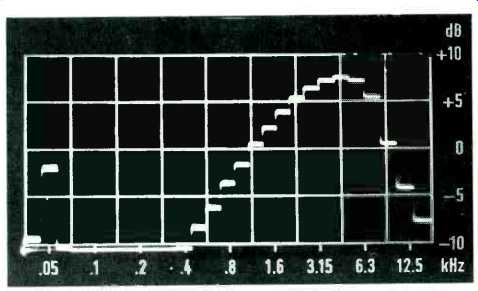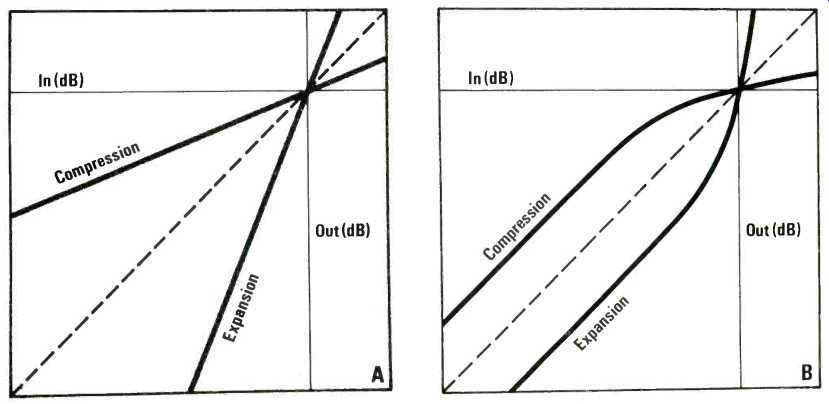by Robert Berkovitz and Kenneth Gundry [Dolby Laboratories, Inc. ]
AN UNSATISFACTORY signal-to-noise ratio has remained the major obstacle to attaining an adequate level of performance from consumer media for music reproduction. This is especially true of the music-cassette, because of its slow tape speed and narrow track width, but it is also true of stereo FM broadcasting and the phonograph record.
Although hopes were raised in recent years that further development of magnetic tape would eliminate its inherent noise as a problem, these hopes have been frustrated by the relatively modest gains achieved, and by studies which indicate that the available signal-to-noise ratio of present-day tapes is very near the maximum value imposed by theory.
It is therefore not surprising that numerous attempts have been made to devise methods of noise reduction satisfactory for professional and consumer use. However, almost all of the methods proposed have had unacceptable drawbacks.
The effectiveness of single-ended (non-complementary) systems, for example, which are designed to be used only during playback, extends only as far as the listener's willingness to sacrifice musical information. In principle, all playback-only systems depend upon the idea that the signal and the objectionable noise occupy separate domains; if this is correct, then the problem of noise reduction is one of defining the boundary between the domains, in terms of frequency and/or level, and designing a circuit to suppress everything on the "noise" side of the boundary. However, if the noise spectrum of ferric oxide cassette tape is taken as an example (see Fig. 1), it is seen that the noise, when passed through a standard DIN weighting network simulating the ear's sensitivity, remains considerable in the 1-4 kHz range. Since this range includes many of the lower harmonics and upper fundamental tones in music, it is not possible to suppress it, even at low listening levels, without serious loss of information. On the other hand, the noise within this range is so disturbing that if it is not reduced by such a circuit, the amount of subjective improvement obtained is minimal.
Complementary methods, i.e., those which require some signal processing or encoding during both recording and playback, offer greater promise, but can also present difficulties when put into practice. Pre- and de-emphasis schemes, for example, in which high frequencies are increased during recording and decreased by the same amount during playback, are only of limited value. Even in FM broadcasting, where such standardized pre-emphasis has been employed for many years, the usefulness of its continued application is in doubt. The primary problem is that modern microphones and recording equipment now routinely reproduce high frequencies at amplitudes so high that they were considered unlikely when current FM standards were set. Broadcasters are now forced to use limiters to prevent overmodulation, if they also wish to maintain reasonable levels at middle and low frequencies. In magnetic tape recording, pre-emphasis is difficult to use because tape saturation occurs at lower levels at high frequencies. Since high-frequency signals already present problems in cassette recording because of their short wavelength, added pre-emphasis would complicate a task which is already difficult.
The compandor type of noise reduction system, in which the dynamic range of the signal is compressed during recording and expanded again during playback, offers more promise. However, a simple compandor, even if precise in its action, also presents problems. In recordings and broadcasting, one of the most serious drawbacks of the compandor is the danger of signal overshoot, which can result in distortion or overmodulation of a transmitter.
An even more serious problem of compandors, from the listener's point of view, is noise modulation. When a conventional full-band compandor is used, low-level passages are recorded at a level higher than normal. They are then played back at reduced level, restoring correct signal dynamics and reducing noise at the same time (see Fig. 2). There can be no noise reduction effect during high-level passages, because this would require increasing the level of such passages during recording, resulting in overload.
The simple compandor therefore requires that one assume that noise is not objectionable when the signal level is high.
However, this is not always the case. A high-level bass drum beat, for example, does not mask high-frequency tape hiss; as a result the drum and other instruments introduce noise modulation during playback--each note is accompanied by a "swish" as the noise level rises for the duration of the note. While it is not audible with all types of program material, noise modulation limits the usefulness of the compandor considerably.

Fig. 1--DIN-weighted noise spectrum of low-noise ferric oxide cassette
tape displayed on screen of real-time analyzer. Vertical scale is relative
only; DIN noise measurement of sample shown was -47 dB with respect to
200 nWb/m. A substantial amount of the noise present falls well within
the range of musical fundamental tones.

Fig. 2--Transfer characteristics of two conventional compandors (solid
lines). A, constant-slope type; B, high-level type. Since compression
and expansion are functions of signal amplitude only, in a single frequency
band, such compandors fail to suppress noise whenever natural masking
fails (see text).
The extreme diversity of available source material and the high quality of present-day master recordings are the factors which really determine the conditions to be met by a satisfactory noise reduction system for home use. It must be remembered that many home listeners own playback equipment with very low distortion and wide frequency range, disclosing audible effects which might have passed unnoticed in earlier times. Therefore, it is especially important that the program be recovered accurately after noise reduction, without addition of any audible sound. For the listener's sake accuracy of recovery and effectiveness of the system should not require adjustment of system parameters to match various kinds of program material. At the same time, the size and cost of the system should introduce no obstacle to its use. Furthermore, as a practical matter for the industry, it is clear that the system should require no modification of present professional practice in master recording, duplicating, or broadcasting.
==========
(adapted from Audio magazine, Sept. 1973)
Also see:
Dolby B-Type Noise Reduction System--Part 2 (Oct. 1973)
Dolby C-Type Noise Reduction (May 1981)
Introducing Dolby S-Type Noise Reduction (Jun. 1990)
EQ & NR: Striking A Balance (Aug. 1988)
Deck to Deck Matching and NR: Straightening the Mirror (Aug. 1986)
A Dynamic Noise Filter for Mastering (June 1972)
= = = =